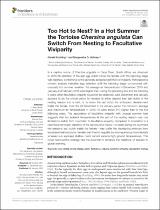| dc.contributor.author | Kuchling, Gerald | |
| dc.contributor.author | Hofmeyr, Margaretha D. | |
| dc.date.accessioned | 2022-07-07T12:25:58Z | |
| dc.date.available | 2022-07-07T12:25:58Z | |
| dc.date.issued | 2022 | |
| dc.identifier.citation | Kuchling, G., & Hofmeyr, M. D. (2022). Too hot to nest? In a hot summer the tortoise Chersina Angulata can switch from nesting to facultative viviparity. Frontiers in Ecology and Evolution, 9, 788764. 10.3389/fevo.2021.788764 | en_US |
| dc.identifier.issn | 2296-701X | |
| dc.identifier.uri | https://doi.org/10.3389/fevo.2021.788764 | |
| dc.identifier.uri | http://hdl.handle.net/10566/7564 | |
| dc.description.abstract | In a captive colony of Chersina angulata in Cape Town, South Africa, we observed
in 2015/16 retention of the last egg clutch inside the female until the hatching stage
was reached, conforming to the generally accepted definition of viviparity. Retrospective
climatic analysis indicates egg retention until the hatching stage co-occurred with
unusually hot summer weather: the average air temperatures in December 2015 and
January and February 2016 were higher than during the preceding five and the following
5 years when facultative viviparity could not be observed. Late December and January
appears to be the critical period for females to either deposit their last clutch of the
nesting season into a nest, or to retain the last clutch for embryonic development
inside the female. Over the 28 December to 24 January period the minimum, average
and maximum air temperatures in 2015–16 were about 3◦C higher than in the five
following years. | en_US |
| dc.language.iso | en | en_US |
| dc.publisher | Frontiers Media | en_US |
| dc.subject | Heat | en_US |
| dc.subject | Rainfall | en_US |
| dc.subject | Climate change | en_US |
| dc.subject | Reptile | en_US |
| dc.subject | Tortoise Chersina Angulata | en_US |
| dc.title | Too hot to nest? In a hot summer the tortoise Chersina Angulata can switch from nesting to facultative viviparity | en_US |
| dc.type | Article | en_US |

